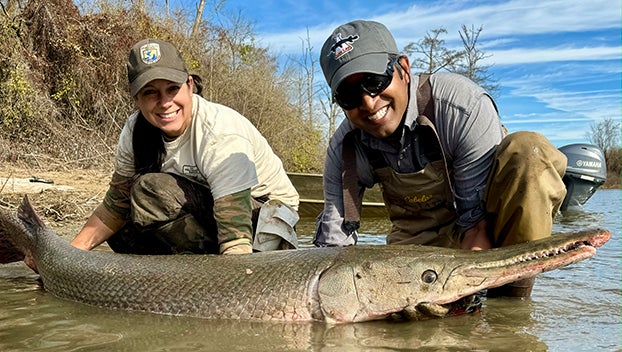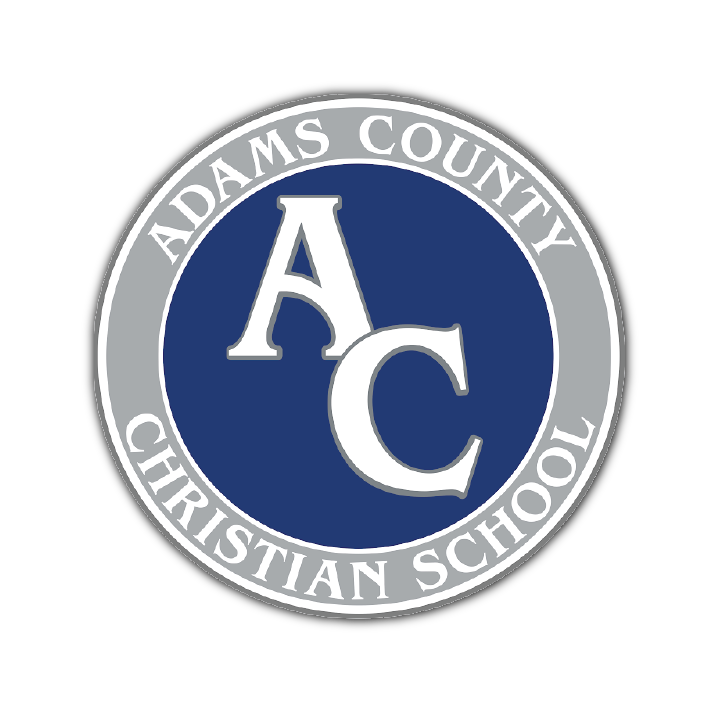Researchers hope to educate, answer more questions with local fish
Published 8:01 am Saturday, December 30, 2023

- USFWS Fisheries Biologist Kayla Kimmel (Left) and University of Minnesota Assistant Professor Solomon David (Right) release a tagged 7-foot-long Alligator Gar into a floodplain lake at Saint Catherine Creek National Wildlife Refuge. (Courtesy Photo | Solomon David)
|
Getting your Trinity Audio player ready...
|
SIBLEY — Local alligator gar are playing a key role in ongoing research projects at St. Catherine Creek National Wildlife Refuge. United States Fish and Wildlife Service and the University of Minnesota hope to answer future questions by continuing to study the gar.
Kayla Kimmel, a Fisheries Biologist with the United States Fish and Wildlife Service and Solomon David, an Aquatic Ecologist & Assistant Professor at the University of Minnesota, and founder of the Gar Lab at Nicholls State University, are working together on research at the refuge.
One question the USFWS would like to answer about St. Catherine Creek NWR is the age structure of its gar. David said he would love to find out how old the gars are there. St. Catherine Creek may allow some of the fish to complete their entire life cycle.
“They come back to this floodplain lake and may very well complete their entire life cycle on the refuge,” David said. “When floodwaters come in, the gars expand out into the floodplain. They spawn on submerged terrestrial vegetation and come back to the lake. Those eggs hatch. A lot of those gar may have stuck around the refuge for their entire life cycle, and that’s really cool. They might migrate far from where they hatched, and may have been around for over 50 years. We would like to find out. Non-lethal techniques to age the fish need to be developed first.”
Kimmel said they can roughly age gar in other locations but fish ages at St. Catherine Creek NWR can vary quite a bit.
David said they hope to educate people about coexisting with the floodplain and more open aquatic connectivity for species like gar. While seasonal flooding of natural areas can be an inconvenience, research has shown the aquatic connectivity provides for a healthier ecosystem. Restoration of the system is key.
Kimmel said the USFWS works with private landowners to help restore and increase connectivity to the Mississippi River for Alligator Gar. She uses a tool to map spawning habitat availability to direct those restoration efforts. St. Catherine Creek’s gar population is helping the USFWS with restoration work.
“This population is teaching us a lot. One thing we are doing is comparing what we learn to other populations,” Kimmel said. “We have stocked gar in other places and we don’t see them do as well. We are learning from this population and trying to apply management information to other places. There is more to learn here as we continue to restore them within their historic range.”
Exceptional drought conditions this summer hammered Mississippi. St. Catherine Creek still had water for the gar but it was much lower than normal. Kimmel reported she didn’t see any fish kills at the refuge but it was the lowest she had ever seen the refuge in 16 years of research work there.
While people might be frustrated with closures of St. Catherine Creek NWR due to flooding in the coming winter, Kimmel said it should be seen as a good thing.
“It is an indicator of a healthy floodplain system and a healthy process. It can be inconvenient and yet it is a good thing still,” Kimmel said. “When it floods it restocks everything from fish to water. It drops some healthy sediment and nutrients onto the ground and benefits everything there from waterfowl to deer.”
Getting involved
While restoration is important, education is also crucial in the mission for sustainable, healthy alligator gar populations. Public involvement is also needed.
During the drought in the surrounding area, Kimmel said people on private land sent videos of gar dying in low water after becoming trapped. People who come across dead alligator gar from similar fish kills can help contribute to research by submitting the heads and total length of the fish so they can be aged.
David said info gathered from the otoliths, ear stones in the skull of the fish, is used to estimate ages and growth rates and help determine health of populations in the state. Anyone who stumbles across dead alligator gar can email David at srdavid@umn.edu or Kimmel at Kayla_Kimmel@fws.gov.
At the research level, David explained the fisheries knowledge about gar is decades behind bass, trout, and catfish. We have a lot of catching up to do to learn about these understudied species of fish.
Gars have a bad reputation as “trash fish” or “rough fish”, they are accused of eating game fish such as bass and even thought to attack humans. None of which are true. Alligator Gar might eat panfish but are more likely to target shad and other abundant food sources.
For the past two years the Oklahoma Department of Wildlife Conservation has hosted Gar Week with David on Twitter and other social media platforms to raise awareness about gar.
“The next generation is doing a better job appreciating the value of gars and that they are really cool animals,” David said. “When I can go to a classroom or out in the field and show students what these fish are like they’re really fascinated, and that’s encouraging about the future.”
One cool fact about alligator gar is they can travel in really shallow water, as shallow as two feet deep. Kayla’s favorite gar species is the Alligator Gar but David can’t pick a favorite. He said it would be like choosing his favorite child among the seven species of gar.
His favorite fact about gar is the fact the gar family has been around for 157 million years. Gar swimming around today haven’t changed much compared to their fossil ancestors.
“They have found a body plan and a way of life that has worked and they haven’t had to change that,” David said. “They have a primitive look to them. A gar today looks similar to one that swam in the Jurassic period.”






